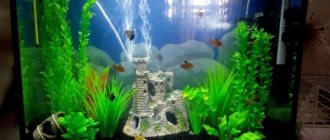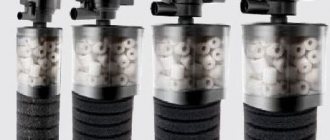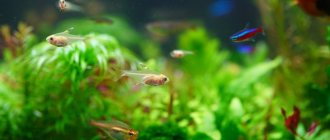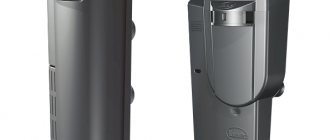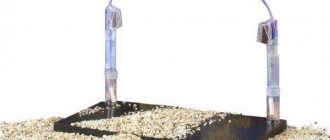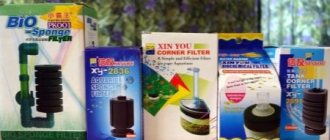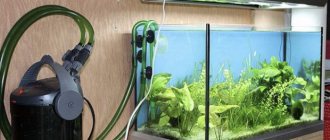Installing a pump in an aquarium
Depending on where the pump is located in the aquarium, its functions may be different. Pumps differ from each other in the installation method and come in three types:
- internal;
- external;
- universal.
The internal pump is installed in the aquarium and can only be used while immersed in water, while external pumps are attached outside the water container. But most often pumps are made universal; they can be installed both inside and outside a water container. To secure the pump both inside and outside, various devices are used, for example, suction cups, special clamps, and so on.
How to choose a pump for an aquarium?
To choose the right pump, you must first of all know the volume of the aquarium, and also decide what the pump will be used for. If it is used to supply water to an aquarium and to create a flow in a small container, then a low-power pump will be sufficient. But for an aquarium with a volume of more than 250 liters, a more powerful pump is needed. There are pumps that are designed for both freshwater and marine aquariums.
And there are pumps that are used only in one specific type of aquarium. Therefore, when purchasing a pump, you should check its type, for which aquarium it is needed, as well as the manufacturer of the pump. Some Russian pumps are in no way inferior to foreign ones in terms of workmanship and durability.
When buying a pump for an aquarium, you should not save money, because the pump is one of the main life support systems for aquarium inhabitants.
In the modern market, buyers most often come across devices from manufacturers such as Eheim, Aquael, Aquarium, etc. The Eheim aquarium water pump successfully copes with increased water circulation, while the regulator slider makes it possible to control the intensity of the created water flow.
The main line produced by the company is Eheim Universal, Eheim Compact and Eheim Compact +. Most of the Eheim models are attached using suction cups and are considered universal, as they can be attached both in the aquarium and on its outer wall. Their productivity is from 270 to 2280 l/hour. You can buy a submersible pump for an aquarium for either 1,000 rubles (with a capacity of 120-380 l/hour) or for 14,000 rubles with a capacity (2,400 l/hour). Features of Eheim pumps include: Small size; Suction cup mount; Possibility of complete immersion in water; Pump power adjustment; Can be used in both salt and fresh water;
Protecting the inhabitants of the aquarium using a protector (fence grid); Stylish appearance; Built-in multifunctional filters. It is with the help of such powerful systems that talented designers create a huge underwater kingdom, where air bubbles “draw” bizarre shapes. For small aquariums where there is no need for expensive and powerful pumps, cheaper pumps can be used.
Devices under the Hailea brand are ubiquitous. Each aquarium pump from this brand is equipped with a water flow regulator, an innovative drain valve and a rubber suction cup. Compared to expensive models from Eheim, they are less attractive in appearance, but at the same time, pumps of this brand successfully cope with their work, which is why they are actively being purchased by people.
You can buy a water pump for an aquarium from this manufacturer for 400-500 rubles, with a capacity of 180 l/hour. If you need the most powerful device, for 6,000 rubles you can purchase a device with a capacity of 7,800 l/hour. Models of the Aquael brand are also known. This is another representative of the budget class - prices for devices start around 300 rubles. For this amount you can purchase the Aquael Circulator 350 model, capable of pumping up to 350 liters per hour, with a power of only 4.5 W. This is the “weakest” model - the manufacturer’s range includes devices labeled as Aquael Circulator 500, 650, 1000, 1500, 2000 and 2600. The number in the label, of course, indicates performance.
The price of the most powerful device is within 4,500 rubles. Another well-known representative is Resun. Models of this brand are also budget - it is often chosen by amateurs who have small aquariums at home. The manufacturer is distinguished by a huge range of devices - there are more than two dozen items in stock. The weakest and cheapest is the Resun SP 500. It can pump up to 200 liters per hour, with a power of 5 W.
Such a device costs only 300 rubles - one of the minimum indicators in its segment. For just 600 rubles, this brand offers to buy a device with a capacity of 1380 liters. The most powerful option is 12,000 l/h: Resun Eco-Power EP-12000. Such a device costs around 6,000 rubles. One of the obvious shortcomings of this brand of equipment is the lack of a regulator - which is not very convenient.
Application and care
Basic pump maintenance consists of timely washing and changing the filter element. There is a trick that can make caring for the device easier: turn off the filter while feeding the fish. This way, food will not fall directly onto the sponges, which means they will stay clean longer. The aquarium pump can start working again an hour after the fish have eaten. An aquarium pump has a huge advantage over a compressor. Many aquarists are forced to abandon the compressor due to the noisy operation of the pump. Most manufacturers aim to reduce the sounds produced.
On the shelves of pet and aqua stores you can find products from domestic and imported manufacturers. They all differ in characteristics and cost. To choose the right pump you need to know:
- The volume of the aquarium in which the water pump will be installed;
- Purpose of use;
- For devices capable of filling an aquarium, the level of water rise is taken into account;
- Required productivity (aquarium volume multiplied by 3-5 times/hour);
- Aesthetics.
Experienced aquarists highlight devices from foreign companies, assuring them of longevity and compliance with the necessary requirements. However, a high-quality aquarium pump is not cheap.
Popular water pump manufacturers:
- Tunze;
- Eheim;
- Hailea;
- Aquarium system;
You shouldn't sacrifice aesthetics for the sake of functionality. Even the smallest water pumps can do the following:
- Create currents that in some cases are necessary for the physiological needs of the inhabitants. Its use is mandatory in aquariums with corals that live only in strong currents. Thanks to it, the polyp receives nutrients.
- Circulate the water (current pump for aquariums or circular pump). This action purifies the water, saturates it with oxygen and mixes with aquarium water, preserving the microclimate created by the inhabitants.
- Provide assistance in the operation of filters, aerators and other devices and units. To do this, you need to install the water pump in such a way that water from the aquarium does not fall on the body.
Popular models
Depending on the model, aquarium equipment varies in power and performance. Thanks to improved design solutions, the capabilities of aerating devices are significantly expanded. Universal pumps are being created that function equally well in sea and fresh water, under water and outside the aquarium.
The most popular:
- Aquael - Polish models with a capacity from 500 to 2000 l/h. The devices use modern energy-saving motors and high-quality sealing rings, which significantly reduce efficiency losses. The devices have smooth flow control and can be used as a circulation pump.
- Juwel Eccoflow are vane pumps made in Germany. The device has a low noise level and automatic cleaning of the impeller chamber. The kit includes two adapters for installation in a Juwel brand filter. Capacity from 300 to 1500 l/h.
- Aqua Medic is a powerful pump designed for saltwater aquariums. Some models are equipped with a controller, with which the device simulates a breaking wave. You can reduce vibration using a magnetic holder. The series includes models with mixing functions, equipped with a device for dosing fertilizers and minerals, and convenient adjustment of water pressure.
- AquaClear - submersible models of compact sizes. They are used to circulate water in the aquarium and saturate it with oxygen. Depending on the model, the maximum pressure ranges from 0.7 to 1.7 m, productivity from 480 to 1500 l/h.
- Deltec - automatic devices for use in aquariums, terrariums and florariums. The pump is designed to work in any liquid, dosing and supplying fertilizers, watering vegetation or filling drinking bowls for insects and rodents. They produce two- and four-channel pumps, there is a controller. Each channel is easily programmed for 24 activations per day. The interval between switching on is a maximum of 30 days. Installation type: submersible and dry. Models with a lift pump have a pause button for feeding.
- Eheim - submersible devices used for constant circulation of water. The performance can be easily changed using the power regulator. Using Eheim water pumps you can create an artificial waterfall and increase circulation. Suitable for use in ornamental gardening and lawn irrigation.
- Jebao - mixing pumps with controller and holder. Suitable for freshwater and marine aquariums. Equipped with a timer to stop the device for 10 minutes and a light sensor. Using the controller, flow strength and power are programmed. With the Master/Slave function, several pumps can be controlled simultaneously.
- Oase is a reliable series of aquarium equipment. Capacity from 300 to 5000 l/h, maximum pressure - 3 m. Suitable for long-term operation.
- Tunze - products are distinguished by their original design, low energy consumption, and the ability to service aquariums of any level. High-strength pumps are mounted using a magnetic holder, operate quietly and do not transmit vibration. A device with a wave generator function ensures uniform water circulation, distributes heat, and fights the accumulation of nitrates. Some models have a protective grille.
- Xilong - produce a series of pumps designed for mixing water in aquariums and outdoor ponds. They are easy to install and disassemble; they are attached to containers with suction cups. The devices are safe for plants and fish and fully meet the requirements of modern aquarium farming.
Structure and principle of operation
A siphon for aquariums, acting like a dropper, is a long transparent hose, to which a wider tube is attached at one end, and at the other - a traction device (similar to a vacuum cleaner) with the ability to drain contaminated liquid. The first part is a glass, a cylindrical funnel (with a diameter of at least 5 cm) or any other suction or receiving device. The second is a special pump, a bulb, or simply the open end of a tube, through which you can independently provoke the outflow of air from the system by inhaling.
Design features and operating principle of the pump
An electrically driven centrifugal pump immersed in aquarium water has a simple design. It consists of a motor and a filter compartment. The stator and rotor with impeller are coaxially placed in the sealed motor housing. The filter compartment is cylindrical in shape with perforations. A multilayer filter is put on it, thanks to which the water sucked in by the pump is cleaned of various particles and suspensions.
The aquarium filter is made of multi-layer sponge. When the engine is turned on, the rotor with the impeller begins to draw in aquarium water, driving it through a sponge filter, and then pushes the cleaned water back through the outlet pipe. Many models have an aerator that saturates the water with oxygen.
Watch a video about aquarium pumps.
Some manufacturers of aquarium pumps, to give the device an aesthetic appearance, place a filter sponge filter in a plastic container. To knowledgeable aquarists, the idea of improving the appearance of the pump seems useless and even harmful. Reducing the volume of the sponge filter makes water purification less effective. After all, the spongy surface is a haven for colonies of nitrifying bacteria, thanks to which the biological purification of the aquatic environment is carried out.
Most aquarists prefer to make aquarium equipment with their own hands. The Internet allows you to find many ideas for making homemade aquarium pumps. For those who want to save their family budget, a pump assembled with their own hands is the best option for a home aquarium; why buy imported equipment, which is too expensive.
Mr. Tail recommends: types of siphons for an aquarium
All siphons for aquariums can be divided into mechanical and electrical according to their structure.
The main difference between them is that the former require active human participation to create traction, while the latter are focused on simplifying the process as much as possible. They are equipped with small motors, powered by batteries or mains power, which will independently power the pump at the user’s request by pressing a button. Another distinctive feature of electronic siphons is that some of them do not contain a hose in their structure, which, in turn, makes them more convenient to use. Moreover, the presence of a filter eliminates the need to change the water: dirt accumulates in a special compartment, without requiring simultaneous pumping of liquid from the reservoir.
However, these models also have disadvantages: carelessness in handling water and current or other violations of operating rules (for example, exceeding the permissible depth threshold of 0.5 m) can easily lead to complete malfunction of the device.
Let's make the pump quiet
UViAQUA.com
Let's make the pump quiet
00:00/ 4:35
Anchor Google Play Listen Notes Player.fm Stitcher iTunes
RSS Feed
Share
Link
Embed
| Play in new window | Duration: 4:35
Subscribe: Anchor | Google Play | Listen Notes | Player.fm | Stitcher | iTunes
Tekhi
— Yuyuyur... I bought a Chinese pump. It's buzzing. It makes it difficult to sleep. What should I do, get a new one?
Yu.V.
— The new one, if it’s branded, will most likely be quieter, yes. But you can also make the Chinese one less noisy. Five minutes of work))
Tekhi
- Yes? Share! Why are they making noise anyway?
Yu.V.
- There may be various reasons.
1. The most common cause of pump noise is air. Even if it seems to you that it is completely deflated, no bubbles are visible in the tubes and on the flute, it is not at all a fact that there is no air at all in the pump chamber. Bubbles can get trapped in pockets of the case, on its uneven surfaces, etc. To completely deflate without radically altering the pump, you can sharply squeeze the outlet hose for a few seconds, and then release it just as sharply. This procedure usually needs to be carried out 3 to 5 times. It helps, but not always, because... There are a lot of different roughnesses, “snot”, and uncut sprues on pumps, especially Chinese ones. This will lead to the second recommendation.
2. Before starting the pump for the first time, it makes sense to go over all rough spots with very fine sandpaper, and then lubricate the entire inner chamber with a thin layer of Vaseline. What gives. Firstly, there is less possibility of trapping air microbubbles. Secondly, on a smooth, lubricated surface, the flow of water is closer to laminar than on a rough surface. This results in less noise (cavitation) and slightly increased productivity. Lubricating the internal cavities helps solve another problem, which is especially noticeable on Chinese pumps. Friction of the impeller against the plane of the housing. Adds a lot of noise.
